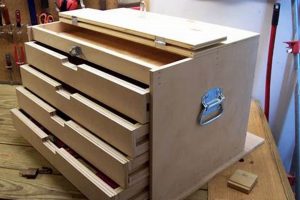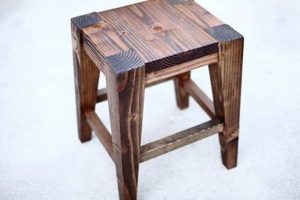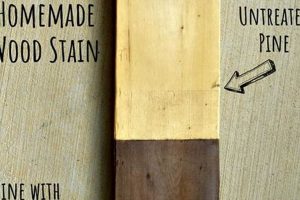A self-constructed striking tool, typically fashioned from hardwood, provides a non-marring alternative to metal hammers. These tools often feature a cylindrical or rectangular head affixed to a handle, both components usually crafted from wood to absorb impact and prevent damage to the workpiece. A common application involves driving chisels or shaping wood without leaving indentation marks.
The creation of such a tool offers several advantages. It allows for customization of size, weight, and material to suit specific project requirements. Historically, wooden mallets have been employed in woodworking, carpentry, and sculpting for delicate tasks demanding controlled force. The use of wood as the primary material minimizes the risk of surface damage and reduces noise compared to metal alternatives. This is particularly valuable in applications involving softer materials or where precision is paramount.
The following sections will explore various design considerations, wood selection criteria, and construction techniques applicable to creating effective and durable striking implements of this type. Emphasis will be placed on methods for ensuring a secure head-to-handle connection and optimizing the tool’s balance for comfortable and efficient use.
Construction Guidance
Effective construction of a wooden striking tool requires careful planning and execution. The following tips outline crucial aspects of the building process to ensure a durable and functional implement.
Tip 1: Material Selection: Choose hardwoods such as maple, beech, or oak for both the head and handle. These species offer superior density and resistance to splitting under repeated impact. Avoid softwoods, which are prone to deformation and premature failure.
Tip 2: Grain Orientation: Orient the wood grain of the head vertically to the striking surface. This configuration maximizes the head’s resistance to splitting. Align the handle grain along its length for optimal strength and flexibility.
Tip 3: Head-to-Handle Joint: Employ a wedged mortise-and-tenon joint for a secure and lasting connection. Ensure the mortise is precisely sized to accommodate the tenon with minimal play. The wedge should be driven tightly to expand the tenon within the mortise, creating a mechanical lock.
Tip 4: Head Shaping: Shape the head to a cylindrical or rectangular profile based on the intended application. Rounding the edges reduces the likelihood of splintering and enhances user comfort.
Tip 5: Handle Ergonomics: Design the handle with a comfortable grip. Taper the handle towards the head for improved control and balance. Consider adding a slight curve to the handle for enhanced ergonomics.
Tip 6: Surface Finishing: Apply a durable finish, such as boiled linseed oil or polyurethane, to protect the wood from moisture and abrasion. This step extends the tool’s lifespan and maintains its aesthetic appeal.
Tip 7: Balance Optimization: Adjust the head size and handle length to achieve optimal balance. A well-balanced tool reduces fatigue and improves accuracy during use.
Adhering to these construction guidelines will result in a durable and functional striking implement suited for a variety of woodworking applications. The next section will provide instructions for a specific construction project.
1. Wood Selection
The choice of wood fundamentally dictates the performance and longevity of a self-constructed striking tool. Proper selection mitigates the risk of premature failure and ensures the tool’s suitability for intended applications.
- Hardness and Density
Wood species vary significantly in hardness and density, directly influencing their ability to withstand repeated impact without deformation or splitting. Hardwoods, such as maple, beech, and hickory, offer superior resistance compared to softwoods like pine or cedar. The increased density absorbs and dissipates energy more effectively, making them ideal for the mallet head. For example, a hickory head is less likely to splinter than a pine head under similar use conditions.
- Grain Structure
The grain orientation and pattern affect the wood’s structural integrity. Straight, consistent grain patterns are generally preferred for both the head and handle. In the head, vertical grain orientation relative to the striking surface is crucial for resisting splitting. Interlocked or wild grain patterns can create weak points, reducing the overall durability of the tool. A consistent grain allows for predictable stress distribution.
- Moisture Content
The moisture content of the wood influences its stability and dimensional stability. Wood that is too wet or too dry is prone to warping, cracking, and shrinking, potentially compromising the head-to-handle joint. Kiln-dried lumber, with a moisture content typically between 6% and 8%, is recommended for mallet construction. This stabilized state minimizes dimensional changes after construction, ensuring a lasting fit and structural integrity.
- Workability
While hardness is desirable for impact resistance, the wood must also be workable with available tools. Extremely hard species can be difficult to shape and join accurately. Species like hard maple strike a balance between durability and workability, allowing for precise shaping of the head and the creation of a tight-fitting mortise-and-tenon joint. Choosing a wood that is both durable and manageable streamlines the construction process and enhances the quality of the finished tool.
Therefore, thoughtful species selection, considering hardness, grain, moisture content, and workability, is paramount for constructing a functional and enduring striking tool. The inherent properties of the wood directly influence its performance and lifespan, emphasizing the importance of informed decision-making during the building process.
2. Joint Integrity
The durability and effectiveness of a self-constructed wooden striking tool are intrinsically linked to the integrity of the joint connecting the head and the handle. A robust joint ensures efficient energy transfer during use and prevents premature failure of the tool, making it a critical aspect of construction.
- Mortise and Tenon Design
The mortise and tenon joint is a common and effective method for securing the head to the handle. The tenon, a protruding element on the handle, is fitted into the mortise, a corresponding recess in the head. Variations exist, including through-tenons, wedged tenons, and blind tenons, each offering different levels of strength and aesthetic appeal. A well-fitted mortise and tenon provides a large surface area for adhesion and mechanical interlocking, contributing to a strong and stable connection. An ill-fitting joint will loosen over time, rendering the tool unusable.
- Wedge Implementation
The addition of a wedge further enhances the security of the mortise and tenon joint. After the tenon is inserted into the mortise, a wedge is driven into a slot cut into the tenon. This action expands the tenon within the mortise, creating a tight, mechanical lock. The wedge material should be of a similar hardness to the handle to ensure uniform expansion and prevent uneven stress distribution. Proper wedging significantly increases the joint’s resistance to separation under repeated impact. Using a metal wedge, for example, would damage the wooden tenon.
- Adhesive Application
While a mechanical joint provides initial strength, the application of a suitable adhesive reinforces the connection and prevents moisture ingress. Wood glue, specifically designed for woodworking applications, provides a strong and durable bond between the tenon and the mortise walls. The adhesive fills any minute gaps, preventing movement and reducing the likelihood of loosening over time. However, relying solely on adhesive without a well-fitted mechanical joint is insufficient for withstanding the stresses associated with mallet use.
- Joint Geometry and Fit
The precise geometry and fit of the joint components are paramount. A tenon that is too loose within the mortise will lack stability, even with adhesive and wedging. Conversely, a tenon that is too tight can induce stress within the wood, potentially leading to cracking or splitting. Careful measurement, precise cutting, and meticulous fitting are essential for achieving optimal joint integrity. A properly fitted joint should require gentle tapping to seat fully, indicating a close and secure fit.
In summation, joint integrity is a non-negotiable aspect of self-made wooden striking tools. The combination of appropriate mortise and tenon design, effective wedge implementation, judicious adhesive application, and precise joint geometry ensures a durable and reliable tool. Neglecting any of these facets compromises the tool’s overall performance and reduces its useful lifespan, reinforcing the significance of meticulous attention to detail during the construction process.
3. Head Weight
Head weight, in the context of a self-constructed wooden striking tool, directly influences the force delivered upon impact. A heavier head generates greater momentum at a given swing speed, translating to a more forceful blow. The selection of an appropriate head weight is therefore critical, determined by the intended application. For instance, a heavier head is advantageous for tasks requiring significant force, such as driving large chisels or shaping thick stock. Conversely, a lighter head provides greater control and precision for delicate work, like fine carving or fitting small components. The correlation between head weight and impact force is linear; doubling the weight theoretically doubles the force delivered, assuming swing speed remains constant. The material density used in the head’s construction is a major determining factor in achieving desired weight.
Practical considerations in determining optimal head weight extend beyond simply maximizing force. Excessive weight can lead to user fatigue, reduced accuracy, and potential damage to the workpiece. Conversely, insufficient weight requires increased swing effort, also contributing to fatigue and potentially compromising control. Therefore, a balance must be struck, considering the type of wood being worked, the frequency of use, and the user’s physical strength. For example, a craftsman predominantly shaping softwoods might opt for a lighter head to prevent overdriving, while a carpenter frequently working with hardwoods would likely prefer a heavier one. The relationship is not static, as individual preferences and project demands introduce variability.
Ultimately, understanding the connection between head weight and force allows for the creation of a more effective and ergonomic tool. Optimizing head weight minimizes user fatigue, improves accuracy, and enhances the overall efficiency of woodworking tasks. Careful consideration during the design and construction phase is paramount for ensuring the tool meets the specific needs of the user, leading to a more satisfactory and productive woodworking experience. This consideration includes not only the overall weight, but the distribution of that weight, and how it affects the tool’s balance.
4. Handle Ergonomics
Handle ergonomics is a pivotal factor influencing the usability and effectiveness of a self-constructed wooden striking tool. The handle serves as the primary interface between the user and the tool; therefore, its design directly affects comfort, control, and the potential for strain or injury. An improperly shaped or sized handle can lead to fatigue, reduced accuracy, and even long-term musculoskeletal problems. Conversely, a well-designed handle enhances grip, minimizes vibration, and allows for efficient transfer of force, optimizing the tool’s performance. The dimensions, shape, and material of the handle must be carefully considered during construction to achieve optimal ergonomics.
Practical examples demonstrate the significance of handle design. A handle that is too thick can be difficult to grip securely, particularly for individuals with smaller hands, leading to reduced control and increased effort. A handle that is too thin can cause discomfort and pressure points, resulting in fatigue. Similarly, the shape of the handle influences grip security and comfort. A handle with a slight curve can conform to the natural contours of the hand, improving grip and reducing strain. The choice of wood also plays a role; hardwoods with a smooth finish are preferable to rough or splintery woods that can cause irritation. The length of the handle influences the swing arc and leverage, factors that need to be considered based on the tool’s intended use. A longer handle provides greater leverage for heavier tasks, while a shorter handle offers more control for delicate work.
In conclusion, understanding the principles of handle ergonomics is essential for constructing a safe and effective wooden striking tool. A well-designed handle minimizes fatigue, enhances control, and reduces the risk of injury. Attention to handle dimensions, shape, material, and finish is paramount. While the construction of a durable head and a strong joint are essential, the handle represents the primary point of contact and interaction with the tool, making its ergonomic design a critical component for maximizing the tool’s utility and ensuring user well-being. Ignoring ergonomic principles can undermine the overall effectiveness of an otherwise well-crafted tool.
5. Surface Finish
The application of a surface finish to a self-constructed wooden striking tool represents a critical step in ensuring its longevity and performance. While the structural integrity of the wood and the strength of the joint are paramount, a proper finish protects the underlying material from environmental factors and wear. Without a suitable surface treatment, the wood is susceptible to moisture absorption, leading to swelling, warping, and ultimately, structural degradation. Conversely, excessive dryness can cause cracking and splitting, weakening the head and handle. The finish acts as a barrier, mitigating these effects and extending the tool’s lifespan. For instance, a mallet used regularly in a humid environment will deteriorate rapidly without a protective coating, while a finished tool can withstand such conditions for years.
The selection of an appropriate finish depends on several factors, including the type of wood, the intended use of the tool, and the desired aesthetic qualities. Oil-based finishes, such as boiled linseed oil or tung oil, penetrate the wood fibers, providing a degree of water resistance and enhancing the wood’s natural appearance. These finishes are relatively easy to apply and maintain, but they offer limited protection against abrasion. Polyurethane or varnish finishes create a more durable, film-forming barrier that is resistant to scratches, impacts, and solvents. However, these finishes can be more challenging to apply evenly and may alter the wood’s natural color. A carpenter using the tool daily might prefer a polyurethane finish for its durability, while a hobbyist might opt for linseed oil to preserve the wood’s natural look. Regardless of the choice, proper application, including thorough surface preparation and multiple coats, is essential for achieving optimal protection.
In summary, the surface finish is an integral component of a homemade wooden striking tool, serving as a protective shield against environmental stressors and physical wear. A carefully selected and applied finish not only enhances the tool’s aesthetic appeal but also significantly extends its lifespan and maintains its structural integrity. Therefore, prioritizing surface treatment is crucial for ensuring a durable and reliable tool, underscoring its practical significance in woodworking and related crafts. Furthermore, the type of finish chosen must be compatible with the adhesive used in the joint, and not interfere with its performance over time.
Frequently Asked Questions
This section addresses common inquiries regarding the design, construction, and utilization of wooden striking tools, providing clarity on best practices and dispelling potential misconceptions.
Question 1: What are the primary advantages of using a wooden striking tool over a metal hammer?
Wooden striking tools minimize the risk of marring or denting the workpiece, particularly when working with softer materials. They also produce less noise and can be customized for specific tasks.
Question 2: Which wood species are best suited for crafting a durable striking tool?
Hardwoods such as maple, beech, hickory, and oak are recommended due to their high density and resistance to splitting under repeated impact. Softwoods are generally unsuitable.
Question 3: How is the head-to-handle joint best secured to ensure longevity?
A wedged mortise-and-tenon joint provides a robust and lasting connection. The wedge expands the tenon within the mortise, creating a mechanical lock. Wood glue further reinforces the bond.
Question 4: What factors influence the optimal head weight for a striking tool?
The intended application dictates head weight. Heavier heads deliver more force for demanding tasks, while lighter heads offer greater control for delicate work. User strength and material hardness also factor into the equation.
Question 5: How does handle ergonomics impact the usability of a wooden striking tool?
A comfortable and well-shaped handle reduces fatigue, improves control, and minimizes the risk of strain or injury. Handle dimensions, shape, and material should be carefully considered.
Question 6: Is a surface finish necessary for a wooden striking tool, and if so, what type is recommended?
A surface finish is essential for protecting the wood from moisture and abrasion. Boiled linseed oil, tung oil, polyurethane, or varnish are suitable options, depending on the desired level of protection and aesthetic.
In conclusion, a properly designed and constructed wooden striking tool offers a versatile and effective alternative to metal hammers. Careful attention to material selection, joint integrity, head weight, handle ergonomics, and surface finish is crucial for creating a durable and functional implement.
The following section offers project ideas.
diy wooden mallet
The preceding discussion has presented a comprehensive overview of the construction and utilization of the self-made striking tool. Key considerations, including wood selection, joint integrity, head weight optimization, handle ergonomics, and surface finishing techniques, have been detailed. These elements collectively determine the implement’s functionality, durability, and suitability for various woodworking applications. The information provides the basis for an informed approach to its design and construction.
The decision to fabricate such a tool represents a commitment to craftsmanship and resourcefulness. While commercially produced alternatives exist, the ability to customize the tool to specific needs and preferences offers a unique advantage. The successful application of these principles can lead to a greater appreciation for the nuances of woodworking and the rewards of self-sufficiency. Furthermore, continued exploration and refinement of techniques will enhance the user’s skills and expand the possibilities for future projects.







